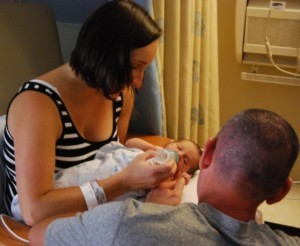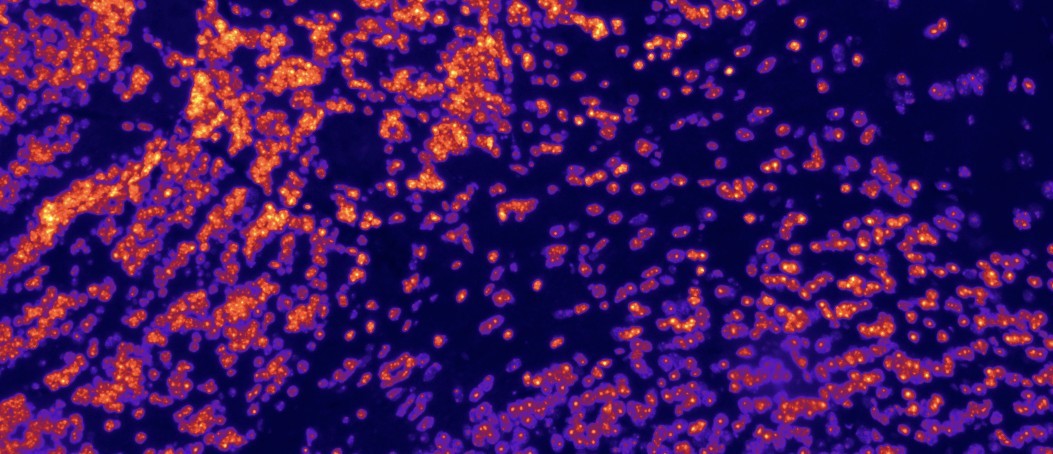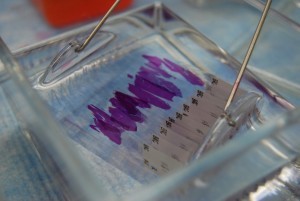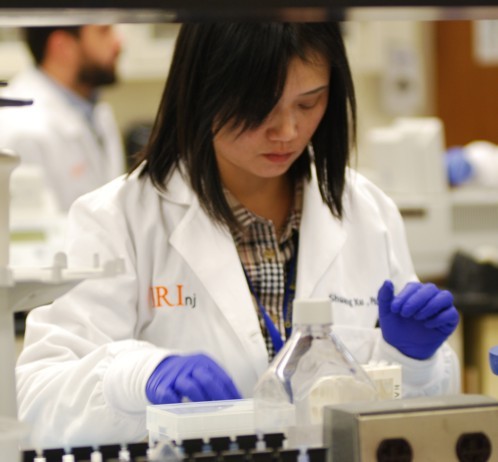A great deal of cutting-edge research, spanning several important areas, is happening under-one-roof at BRInj. For example, scientists are actively engaged in projects in neuroscience, neonatology, nutrition, infectious disease, surgery and oncology. A few of these exciting projects are described here.
Neonatal Nutrition: Determining which breast milk components are most protective
 Babies that spend time in the NICU are often born prematurely and of a very low birth weight. They are very fragile and their nutrition can impact their long-term health. Recent studies have shown that breast milk protects NICU infants from developing a complicated intestinal infection called Necrotizing Enterocolitis (NEC) and may also contain other irreplaceable healthful components. Researchers at BRInj are actively collecting, storing and analyzing donor breast milk in order to better understand the ways in which it benefits NICU babies, and are developing a physiologically-relevant model of NEC. These projects have led to a multidisciplinary clinical and scientific collaboration.
Babies that spend time in the NICU are often born prematurely and of a very low birth weight. They are very fragile and their nutrition can impact their long-term health. Recent studies have shown that breast milk protects NICU infants from developing a complicated intestinal infection called Necrotizing Enterocolitis (NEC) and may also contain other irreplaceable healthful components. Researchers at BRInj are actively collecting, storing and analyzing donor breast milk in order to better understand the ways in which it benefits NICU babies, and are developing a physiologically-relevant model of NEC. These projects have led to a multidisciplinary clinical and scientific collaboration.
Why is this important? NEC is a leading cause of death and disability among fragile NICU infants. The disease and the ways in which infant nutrition impacts its outcome are not well-understood. We believe these projects will lead to NEC prevention, new treatment strategies and overall improved infant nutrition.
Who Benefits? NICU Infants
How can you help? Your contribution will off-set costs associated with the NICU Breast Milk Donation Program, research materials, and investigator salaries.
Bioresouce Center: A “rapid response’ biorepository for researchers
Biobanks are secure repositories of donated biological samples and information saved for research. Biobanks give scientists and physicians the opportunity to study important clinical questions using actual human tissue, blood or cells that has been safely collected with permission from patients. Samples stored in biobanks can be used for years to come, therefore, a single donated sample may help to us solve an important medical problem, lead to the development of a new therapy, and allow for the identification of a novel disease biomarker. The BioResouce Center (BRC) at BRInj is a biorepository that contains several individual biobanks, including a Brain Bank, a Neonatal Biobank, and a Lyme Disease Biobank. The BRC is actively collecting samples for several on-going studies.
Why is this important? Once samples are stored in the BRC, they are readily available for research studies. That means that scientists can rapidly have access to the biological samples they need to conduct important research; saving valuable time, resources, money, and patient lives.
Who Benefits? Initially, these resources will be used by physicians and scientists hoping to better understand disease and to provide better treatment strategies to their patients, and clinicians’ intent to more effectively diagnose various conditions. Ultimately, it will impact the population at large by leading to important treatments and therapies for unmet medical needs.
How can you help? Your contribution will off-set costs associated with the biosample collection, research materials, storage coordinators, and personnel costs.
Regenerative Medicine Program: Reversing the Effects of Disease and Injury
Recently, the use of stem cells to treat various medical conditions has gained momentum. It’s believed that this type of therapeutic strategy may be accomplished by either introducing exogenous stem cells into a damaged area, or by stimulating the production and maturation of endogenous cells. Stimulating endogenous progenitor cells to evolve into mature, functional cells is particularly intriguing, and eliminates the ethical issues associated with using exogenous stem cells. Using our “Agonist Induced Recovery” approach, we have shown that we can repair cellular damage in several devastating medical conditions. Our challenge is to more thoroughly evaluate this approach, and to find ways to bring this approach to the patient.
Why is this important? Imagine if scientists and doctors had the ability to re-grow cells that had been damaged due to disease or injury, and if by doing so, they could reverse or slow-down the adverse clinical effects experienced by a patient. Using a technique called “Agonist Induced Recovery”, scientists at BRInj are developing therapies to accomplish this task. In their first example, they utilized a drug that binds to a specific cell type lost in Parkinson’s disease, and in as little as thirty days, the drug led to significant improvements in a model of Parkinson’s disease. These researchers are now testing this technology in other disease models, like Alzheimer’s disease, diabetes, and heart disease, and they are working hard to move these therapies to the clinic.
Who Benefits? Initially, these resources will be used by physicians and scientists hoping to provide better treatment strategies to their patients, and clinicians’ intent to more effectively diagnose various conditions. Ultimately, it will impact the population at large by leading to important treatments and therapies for unmet medical needs.
How can you help? Your contribution will off-set costs associated with the research materials, investigator wages, laboratory equipment and therapeutic modeling.





